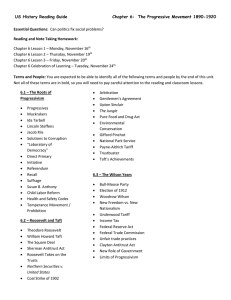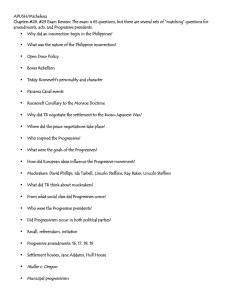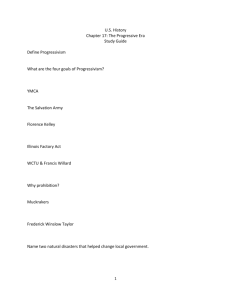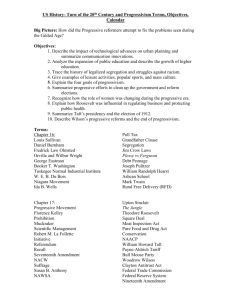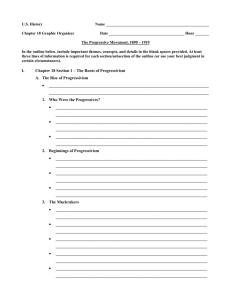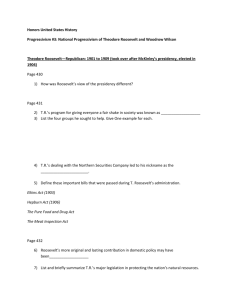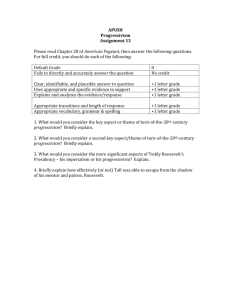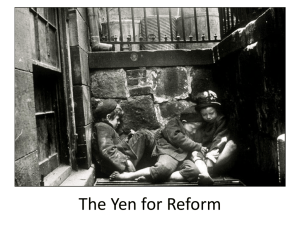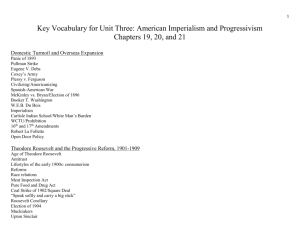TopicSix.Progressivism.doc
advertisement
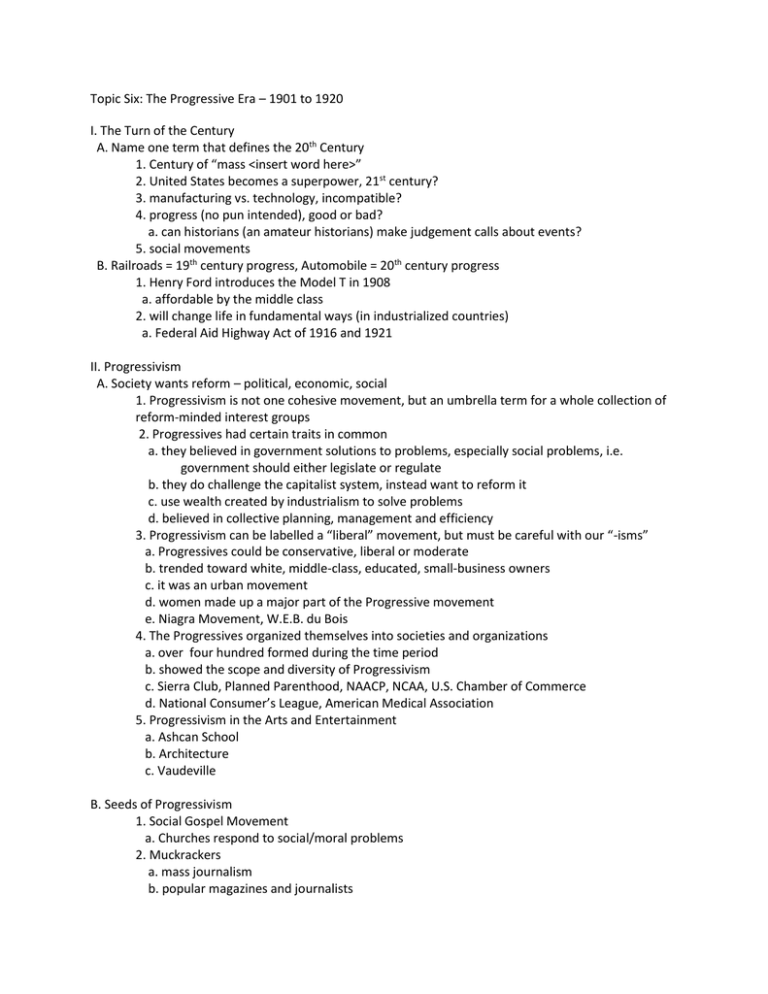
Topic Six: The Progressive Era – 1901 to 1920 I. The Turn of the Century A. Name one term that defines the 20th Century 1. Century of “mass <insert word here>” 2. United States becomes a superpower, 21st century? 3. manufacturing vs. technology, incompatible? 4. progress (no pun intended), good or bad? a. can historians (an amateur historians) make judgement calls about events? 5. social movements B. Railroads = 19th century progress, Automobile = 20th century progress 1. Henry Ford introduces the Model T in 1908 a. affordable by the middle class 2. will change life in fundamental ways (in industrialized countries) a. Federal Aid Highway Act of 1916 and 1921 II. Progressivism A. Society wants reform – political, economic, social 1. Progressivism is not one cohesive movement, but an umbrella term for a whole collection of reform-minded interest groups 2. Progressives had certain traits in common a. they believed in government solutions to problems, especially social problems, i.e. government should either legislate or regulate b. they do challenge the capitalist system, instead want to reform it c. use wealth created by industrialism to solve problems d. believed in collective planning, management and efficiency 3. Progressivism can be labelled a “liberal” movement, but must be careful with our “-isms” a. Progressives could be conservative, liberal or moderate b. trended toward white, middle-class, educated, small-business owners c. it was an urban movement d. women made up a major part of the Progressive movement e. Niagra Movement, W.E.B. du Bois 4. The Progressives organized themselves into societies and organizations a. over four hundred formed during the time period b. showed the scope and diversity of Progressivism c. Sierra Club, Planned Parenthood, NAACP, NCAA, U.S. Chamber of Commerce d. National Consumer’s League, American Medical Association 5. Progressivism in the Arts and Entertainment a. Ashcan School b. Architecture c. Vaudeville B. Seeds of Progressivism 1. Social Gospel Movement a. Churches respond to social/moral problems 2. Muckrackers a. mass journalism b. popular magazines and journalists 3. The Settlement House Movement a. Twenty Years at Hull House, (1910), by Jane Addams b. social work c. what values do they instill (positive or negative?) 4. Populism a. rural movement C. Progressivism at the Local and State Level 1. Cities a. Public Parks, Community Centers b. city managers, professional managers c. water treatment facilities, sewer systems, garbage pickup d. electricity and gas e. professional services, police and fire f. zoning laws g. health clinics and hospitals 2. States a. regulatory commissions b. direct primaries c. recall, initiative, referendum d. state employee pension, widow’s pension III. Progressivism at the National Level, The Progressive Presidents A. Theodore Roosevelt, 1901 to 1909 1. Becomes president when McKinley was assassinated a. was the youngest president to date at 42 b. from a very wealthy New York family c. was the first “superstar” president d. believed that the presidency was a “bully pulpit” in which to govern 2. nicknamed “Trustbuster” because 43 anti-trust suits brought under his presidency a. 1906, Standard Oil b. Henry Clay Frick, “we bought the son of a bitch and he didn’t stay bought” c. however, Roosevelt didn’t believe in destroying big business, but in regulation 3.United Mine Workers Strike, 1902 4. Department of Commerce and Labor created 1903 5. Roosevelt is re-elected in 1904, program of regulation from Congress a. Hepburn Railroad Act, 1906 b. Pure Food and Drug Act, 1906 c. Meat Inspection Act, 1906, reaction to The Jungle, by Upton Sinclair d. Antiquities Act, 1906 6. Conservation a. U.S. Forest Service created and expanded National Forest System b. Yes, the teddy bear is named after Theodore Roosevelt B. William Taft, 1909 to 1913 1. Easily wins the election because of Roosevelt’s endorsement a. our heaviest president, not charismatic like Roosevelt b. had served as a federal judge c. Governor of the Phillipines 2. Progressive legacy a. expands Parks Service b. opens more anti-trust suits than T.R. c. Mann-Elkins Act, (1910) d. 16th Amendment passes Congress in February 1913 e. Public Health Service created in 1912 3. However protective tariff passed under Taft a. manages to alienate both progressives 4. Election of 1912 a. Theodore Roosevelt and William Taft split the Republican vote b. Democrat Woodrow Wilson wins the election C. Woodrow Wilson 1. Governor of New Jersey, academic a. moralistic, self-righteous, God ordained his victory b. re-segregates the Federal Government 2. Make big business smaller (destroy it) a. Underwood Simmons Tariff, lowers tariff drastically 3. Four constitutional amendments a. 16th, income tax b. 17th, direct election of senators c. 18th, Prohibition d. 19th, vote for women 4. Federal Reserve Act a. creates the Federal Reserve System 5. Federal Treade Commission created 6. Louis Brandeis appointed to Supreme Court 7. Worker’s Compensation for Federal employees 8. Keating-Owen Act, child labor law 9. Wilson re-elected in 1916 a. because of foreign policy, not domestic 10. by 1914, foreign policy will dominate Wilson’s presidency
